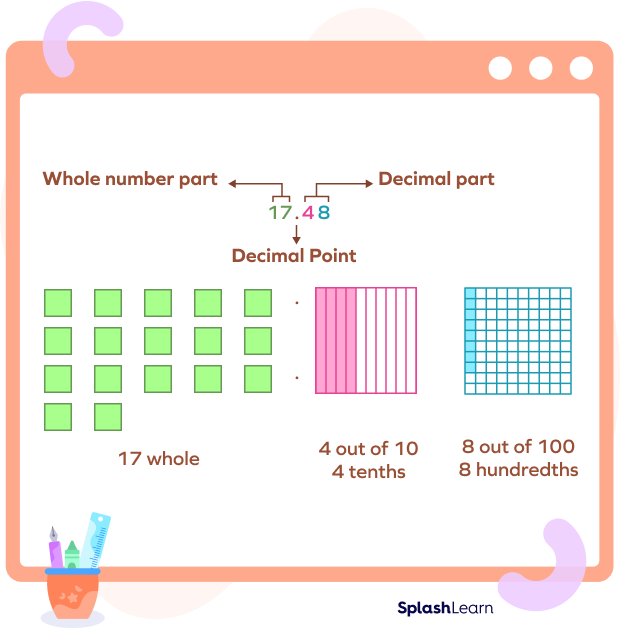Decimal – Introduction
A decimal is a number that consists of a whole and a fractional part. Decimal numbers lie between integers and represent numerical value for quantities that are whole plus some part of a whole.
For example, in the given image, we have one whole pizza and a half of another pizza. This can be represented in two ways:

Fractional form: In fraction form, we can write that there is one and one-half of a pizza. That is $1\frac{1}{2}$ pizza.
Decimal Form: In decimal form, we will write this as 1.5 pizzas. Here, the dot represents the decimal point and the number before the dot, i.e., “1” represents one whole pizza and the number behind the decimal point represents the half pizza or the fractional part.
You might have seen decimal numbers like these when you go grocery shopping or on a weighing machine or even a game of baseball!
Recommended Games
What is a Decimal?
We get decimals when we break a whole into smaller parts. A decimal number then has two components: a whole number part and a fractional part. The decimal place value system for the whole part of a decimal number is the same as the whole number value system. However, we get the fractional part of the decimal number as we move toward the right after the decimal point. The given image shows the decimal place value chart:

Note that as we go from left to right in the decimal place value system, each values is $\frac{1}{10}$ times smaller than the value to its left.
The first place after the decimal point is called the “tenths”, which represents a place value of $\frac{1}{10}$ of the whole or one-tenth of the whole. In decimal form, this fraction is written as “0.1”.
Such fractions whose denominator is 10 or a positive power of 10 is called a decimal fraction.
The second place is called the “hundredths”, which represents a place value of $\frac{1}{100}$ of the whole or one-hundredth of the whole. In numerical form, this decimal fraction is written as “0.01”.
And the third place is called the “thousandths”, which represents a place value of $\frac{1}{1000}$ of the whole or one-thousandth of the whole. In numerical form, this decimal fraction is written as “0.001”.
Here’s an example of a decimal number 17.48, in which 17 is the whole number, while 48 is the decimal part.

Recommended Worksheets
How to Read a Decimal?
An informal way to read a decimal is by reading the whole part of the decimal number as you would read any whole number and then reading the decimal dot as “point” and then reading each digit of the rational part individually.
For example, the number 17.48 would be read as “Seventeen point four eight”.
However, a more formal way to read decimals is to read the whole part as a whole number, then the decimal dot as “and” and then reading the fractional part altogether but using the place value of the last digit with it.
For example, take a look at the given number
25.678
Here, the whole part is 25 and the place value of the last digit, 8, is thousandths. So we will read this number as “Twenty-five and six hundred seventy-eight thousandths”.
Types of Decimals
Based on the number of digits after the decimal point, the decimal numbers can be divided into two categories:
Like decimals: Two decimal numbers are said to be “like” decimals if they have the same number of digits after the decimal point. For example, 6.34 and 2.67 both have two digits after the decimal point so they are Like decimals.
Unlike decimals: Two decimal numbers are said to be “unlike” decimals if they have different number of digits after the decimal point. For example, 5.3 and 6.873 both have different number of digits after the decimal point so they are unlike decimals.
Solved Examples On Decimal
Example 1: In which place does the underlined digit lie in 56.782?
Solution:
The underlined digit is in the third place after the decimal point. The first place after the decimal point is tenths, the second place is hundredths and the third place is called thousandths. Hence, the undersigned digit is in the thousandths place.
Example 2: What is the place value of the underlined digit in 45.82?
Solution:
The underlined digit, 8, is in the tenths place. Hence, its place value is 0.8.
Example 3: Give an example of like decimals.
Solution:
Two decimal numbers are said to be like decimals if they have the same number of digits after the decimal point. Example: 5.99 and 3.65
Practice Problems On Decimal
Decimal – Definition with Examples
Which of the following pairs of decimals are like decimals?
Because these are the only pair of decimal numbers that have the same number of digits after the decimal point.
In what place does the underlined digit in $6.8\underline{9}3$ lie?
The underlined digit is in the second place after the decimal point. The first place after the decimal point is tenths, the second place is hundredths.
Which number is in the tenths place in 34.987?
The first place after the decimal point is the tenths place and in the given decimal number, the digit 9 is in the tenths place.
What is the place value of the underlined digit in 124.64$\underline{8}$?
The underlined digit “8” is in the thousandths place. Hence, its place value is 0.008.
Frequently Asked Questions On Decimal
What are some applications of decimals in daily life?
A common application of the concept of decimals is in monetary transactions. A dollar is made up of 100 cents, and the prices of objects are written in decimals, such as USD 2.79. Other applications are mainly concerned with the precision required in the field, such as scientific research, sports, jewelry, and vehicle gas meters.
What is the difference between decimal numbers and integers?
All integers can be written as decimal numbers. For example, the integer 5 can be written as 5.00. But not all decimal numbers can be written as integers since integers are whole and do not have a fractional part, but decimal numbers have a fractional part and hence can only be written as fractions.
How do you read a decimal number?
A decimal number is read by saying the whole part of it as a whole number and by individually reading out every number after the decimal point. For example, 27.69 would be read as twenty-seven point six nine.




































